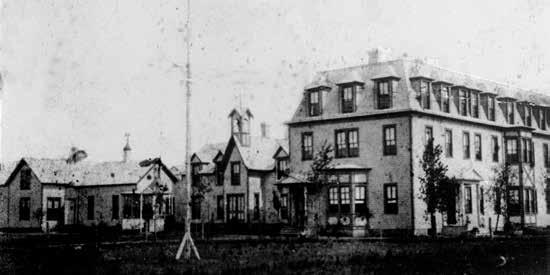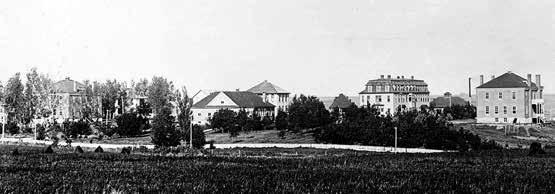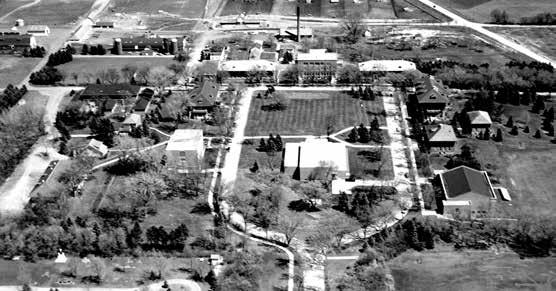
3 minute read
60 YEARS SINCE 1960
6O YEARS SINCE 1960
The first decade of our campus’s life as a university coincided with a decade of turmoil and change in our nation and around the world. Today, in 2020, we again find ourselves in the midst of widespread social movements. The movements of the 1960s made us who and what we are now, as will those we are experiencing today. This year marks our 60th anniversary. Although we’re unable to celebrate together on campus this fall, we hope you will take some time to reflect on our history and the strong foundation we have built for a long and bright future.
A BRIEF HISTORY OF CAMPUS Educational Experiments in Three Acts
ACT I: AMERICAN INDIAN BOARDING SCHOOL, 1887–1909 The University of Minnesota Morris makes its home on lands first inhabited by the Anishinaabe and Dakota/Lakota people. The first campus buildings housed an American Indian boarding school, first administered by the Sisters of Mercy order of the Catholic Church and later by the United States Government. The school closed in 1909, and the campus was transferred to the State of Minnesota with the stipulation that American Indian students “shall at all times be admitted to such school free of charge for tuition,” a policy still proudly honored.
ACT II: WEST CENTRAL SCHOOL OF AGRICULTURE, 1910–63 In 1910 the University of Minnesota established the West Central School of Agriculture (WCSA) on the Morris campus, which educated area high school students in a boarding school environment until 1963. It is this time period that garnered the campus its placement on the National Register of Historic Places as the West Central School of Agriculture and Experiment Station Historic District. Handsome Prairie School structures, such as Behmler Hall and the Education building, built during the WCSA years and designed by well known state architect Clarence H. Johnston, Sr., continue to serve the campus well.
The campus in 1896. These buildings stood on the present-day campus mall.

Campus ca. 1909, around the time the WCSA was founded. The building at the far right is the only building now remaining from this time and is known as the Multi-Ethnic Resource Center.
ACT III: UNIVERSITY OF MINNESOTA MORRIS, 1960–PRESENT In the late 1950s when the University of Minnesota announced that agricultural schools would be phased out, a grassroots citizens movement convinced the Minnesota Legislature that creating a distinct public liberal arts college within the University of Minnesota System on the Morris campus would be a good investment for the state.

In September 1960 the University of Minnesota Morris opened its doors and began fulfilling its institutional vision to be an affordable, undergraduate, intentionally small, residential, public liberal arts college.
Aerial view of campus in 1960, when the university opened its doors. For three years, the WCSA high school and the university operated on campus simultaneously.
THEN AND NOW-ISH
CA. 1960

2012 Seems like we only manage to get a group of faculty together for a photo about once every 50 years! Figuratively, though, our faculty today stand shoulder-to-shoulder with their counterparts from the early years, dedicated to providing an excellent public liberal arts education for students from all walks of life. Ca. 1960, University of Minnesota Morris faculty. Seated 2012, UMN Morris faculty who were teaching at the time and had L-R: Ralph Williams, Rodney A. Briggs, Racheal Munson, won the Horace T. Morse-University of Minnesota Alumni Judy Schradel, Mildred Gausman. Standing: L-R: Herbert G. Association Award for Outstanding Contributions to Croom, Richard W. Burkey, Theodore Long, Calvin Pederson, Undergraduate Education. Standing: Gwen Rudney, Roland Donald Gray, James Olson, Stephen G. Granger, John B. Heald, Guyotte, Janet Schrunk Ericksen, Jim Cotter, Bart Finzel, Jon Bruce Nord, W. Donald Spring, Karl R. Bornhoft, Jay Roshal, Anderson, Pieranna Garavaso, Leslie Meek. Seated: Engin James C. Gremmels, Glenn H. Daniels, John Imholte. Sungur, Peh Ng, Nancy Carpenter, Jeff Ratliff-Crain, Jim Togeas
1960

2019 Students today may dress a little differently from their 60-years-ago versions, but they’re often here for some of the same reasons: to get a great education from faculty who care about them as people!
1980

ca. 2000 2018
UMN Morris is a university, so of course there were classes then, and there are classes now, but what about extracurriculars? Seems like making music on the mall has been a constant through the decades!



